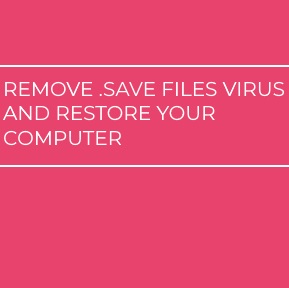save Files Virus (Dharma Ransomware) - Verwijder het - 4 minutes read
 save Files Virus (Dharma Ransomware)
save Files Virus (Dharma Ransomware)The .save files virus is a new release of the Dharma ransomware family which appears to be aimed against users worldwide. Like previous versions it may launch a sequence of dangerous modules that can cause many issues on the affected systems. In the end file encryption will take place and as a result sensitive user data will be made unavailable. The victim users will be extorted in order to pay a “decryptie vergoeding”.
Aangezien de .save files virus is a new Dharma ransomware version we anticipate that it distributed against the same tactics as previous iterations. Dit omvat de coördinatie van de phishing campagnes which are made in both email and sites forms. They originate from well-known addresses and may include stolen content that will confuse the recipients into interacting with them.
The other common way of spreading the virus installation code is through the insertion of the threat in payload carriers. They can be both geïnfecteerde documenten in alle populaire bestandsformaten en ook setup pakketten of popular applications which are often downloaded by end users. They can also be found on file-sharing netwerken and other sources. Frequently the infections can also be caused through the interaction with malware browser plugins (ook bekend als “kapers”) which are often found on the relevant repositories with fake user reviews and developer credentials.
The .save files virus as a new Dharma ransomware release will follow the malicious behavior patterns that were identified in previous versions. This will usually start a series of dangerous modules in a predefined sequence. It usually starts with a data oogstproces which is used to extract information both about the users and their machines. It can be used for crimes like identity theft and each compromised machine can be uniquely identified with a set ID.
This information can then be used to identify if there are any installed security applications that will be bypassed. Usually the engine will look for engines of anti-virus programs, firewalls, sandbox omgevingen en virtual machine hosts.
When the .save files virus has completed its primary intrusion it will proceed with various systeemveranderingen. Deze omvat laarsopties veranderingen which will automatically start the engine when the computer is powered on. A related consequence is the blocking of the ability to enter into some of the recovery options making it very difficult to follow most manual user recovery guides.
This can be followed by Windows-register wijzigingen which will usually lead to performance and stability issues, along with data loss and unexpected errors. In addition the made infections can be used to deploy other malware to the hosts including the following: Trojans, mijnwerkers en omleidingen.
The encryption phase will be launched as the final component and it will use a strong cipher in order to process target user data. All of these files will receive the .save extension. To blackmail the victims into paying the hackers a special “honorarium” a ransomware note will be produced.
The .save Files Virus is a crypto virus programmed to encrypt user data. Zodra alle modules klaar uitgevoerd in de voorgeschreven volgorde LockScreen zal een applicatie frame dat wordt voorkomen dat de gebruikers interactie met hun computers starten. Het zal de ransomware nota aan de slachtoffers weer te geven.
Als uw computersysteem raakte besmet met het .save Files ransomware virus, moet je een beetje ervaring hebben in het verwijderen van malware. U dient zich te ontdoen van deze ransomware krijgen zo snel mogelijk voordat het de kans om verder te verspreiden en andere computers te infecteren kan hebben. U moet de ransomware te verwijderen en volg de stap-voor-stap instructies handleiding hieronder.
Source: Sensorstechforum.com
Powered by NewsAPI.org
Keywords:
Computer virus • Dharma • Ransomware • Computer virus • Dharma • Ransomware • User (computing) • Computer • Personally identifiable information • Computer virus • Dharma • Ransomware • Phishing • Email • Computer virus • Application software • End user • File sharing • Malware • Software developer • Computer virus • Dharma • Ransomware • Software release life cycle • Malware • Modular programming • Data • Information • User (computing) • Machine • Identity theft • Information • Security • Application software • Antivirus software • Firewall (computing) • Sandbox (computer security) • Virtual machine • Server (computing) • Computer virus • Computer • Block (data storage) • Command-line interface • Man page • User (computing) • Microsoft Windows • Processor register • Data loss • Software bug • Malware • Server (computing) • Trojan horse (computing) • Encryption • Encryption • Personally identifiable information • Plug-in (computing) • Security hacker • Ransomware • Computer virus • Cryptography • Computer virus • Hungarian language • Ransomware • Ransomware • Computer virus • 'n Beetje • Malware • Ransomware • Ransomware •